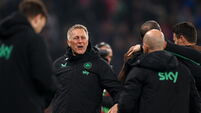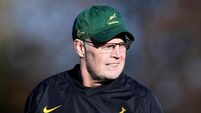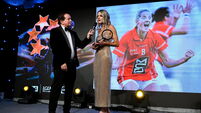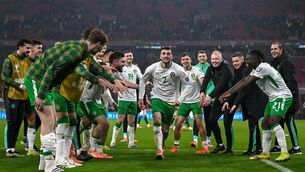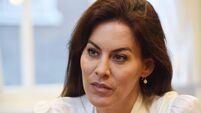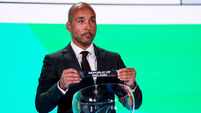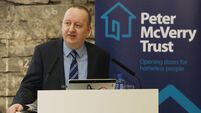John Riordan: Marathon's return brings out best of New York City's humanity
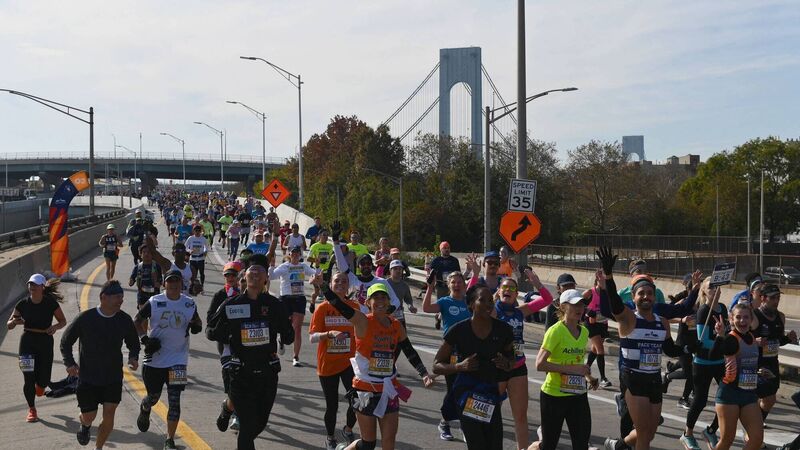
Runners participate in the 2021 TCS New York City Marathon in New York on November 7, 2021. - After a forced break in 2020, the New York City Marathon is back on for its 50th edition, and with it the countless opportunities to run it for charity, an industry that has become a staple, and hopes to take off again after the pandemic. (Photo by ANGELA WEISS / AFP) (Photo by ANGELA WEISS/AFP via Getty Images)
“All right Johnny Boy?!”
I was just over a mile into Sunday’s 50th New York City Marathon and already I was able to enjoy a familiar face and a familiar sound. Right there in the midst of, infamously, the most difficult opening salvo of any world major, Paul McDaid landed at my right shoulder, smiling and shaking my hand.
“Paulie!” I hollered back, “we did it!”
I had been feeling more than all right and now I was feeling even better as we pushed our way over the Verrazano Bridge leading us from Staten Island to Brooklyn.
Way across the harbour, Lower Manhattan looked beautiful as it bathed in the early morning sun. But it also looked much too distant and that wasn’t even half the battle; the Bronx and Central Park being so much further north.
It didn’t matter yet. The thousands of runners departing as part of our second group of non-professionals used the acoustics of the lower level of the bridge to send waves of happy sounds back and forth. Above us on the upper level, I noticed the shadows of more runners cast against the concrete of this interminable bridge. It was reassuring to see them pressing on ahead, just like us.
This was the hardest part, they said. Don’t get carried away. Stay nice and relaxed. But McDaid didn’t hang back nor did his three friends and running mates, Dylan McCabe, Hugh Murray and Jamie Bannigan. I high-fived each of them as they powered onwards, all five of us ecstatic and looking forward to the mystery ahead.
It was the first official New York City Marathon outing for McDaid and myself and neither of us had a clue about what we were doing.
We arrived in New York from Ireland the same October weekend in 2010. We were strangers from Cork and Sligo and it would be a couple of years before we would unearth the happy coincidence as we got to know each other at the Shamrocks Soccer Club. In 2020, his East Village bar Jackdaw was a much needed refuge for those of us marooned in the city and not allowed to go back to visit Ireland.
Much was made of the fact that this run was the celebratory comeback of the city which was among those most scuppered by the events of last year. Such is the marathon’s elevated profile and heightened international appeal that the US Government saw fit to wait to lift the EU travel ban until a day after, thus avoiding a rush to the borders by starved international runners who now will miss their favorite race for the second year in a row.
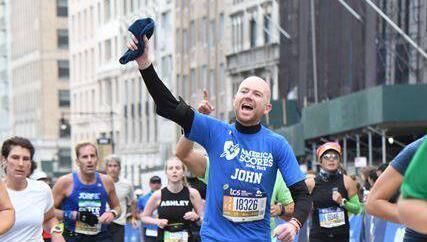
Normally boasting a field of 50,000, on Sunday 25,000 defiant runners took the early ferries and buses from Manhattan to the oft-forgotten fifth borough. All the way along the route, almost a million people gathered to celebrate another hint that life was returning closer to normal.
As unprepared as I was to run for almost four hours, the element I was least expecting was the power of those crowds. In so many sections, they kept me going at times when really I should have been tossed into the East River.
This was a whistle stop tour of the diversity of this great city and the strongest validation of the values of the American experiment which have been tossed aside by so many in recent years.
As we entered Bay Ridge, the first spectators started to become visible. Brooklyn Italians waved flags on the paths and the stoops, very aware that this was a rare visit by outsiders but it is what it is.
Turning onto Fourth Avenue, the flags soon became Mexican and the energy lifted even more. The little ones offered their hands for high fives and I shouted “Viva México” in honour of my relatively new brother-in-law.
These are all the sentimental thoughts that flow through your brain as you pray for the next mile marker to appear. I was in my element and if I hadn't planned to stay close to an experienced pacer, I would have lost the run of myself and paced too fast, buoyed by the energy of the onlookers. I slowed down to wait for him and gave out a few more high fives.
Across the avenue, I managed to spot my first set of familiar faces and waved over enthusiastically, almost crashing into a runner in front of me. That was bad etiquette but I was out of control now.
The turn on to Lafayette Avenue in the heart of upscale Park Slope was thronged and what else was there to do but wave at all these people? They had the best view of us as we approached the sharp right, still high on energy and still in good form as brass bands rocked out and the sun rose higher behind our backs.
This was probably the first time when I allowed my mind to wonder how long this would all take. I hadn’t trained for this and the last time I had done any significant amount of running was a half marathon in March. A soccer injury intervened and I had decided that rest was my best hope for survival on the day itself.
Right when the doubts began to enter my mind, the streets became noticeably quieter as I reached the Hasidic Jewish section of South Williamsburg. The residents couldn’t have been less interested and it suddenly became apparent to my first-timer eyes how vital the crowd was going to be.
On the other side of Broadway, as South Williamsburg gave way to the Northside, there was a resurgence of chaos. Bedford Avenue was claustrophobic but joyful. This was the first time where my doubts were cast aside by these happy New Yorkers. At North Sixth Street, I hugged Lizzie and I high fived the Youghal Italian Patrick Del Punta whose Sweetwater restaurant fought the bravest fight that I know of during March, April and May last year for the sake of keeping their beloved employees on their payroll.
Somehow I was still keeping track of the pacer and I was also close enough to the spectators that I could hear them calling out my name. It was on the front of my shirt which is a common tip for those of us who need the boost and, as it happens, it was worth about five or six extra miles at least.
As I approached and passed the halfway mark, it was suddenly apparent that I needed these people more and more. Bennett at the Pulaski Bridge, Katie and Kara in Long Island City, Cormac just before the Queensboro Bridge where the doubt was really ready to take hold.
It was just us runners now - no noise and no hope. My pacer disappeared off up the hill and I stopped worrying how long it had been since I had consumed my last overly caffeinated gel. It was suddenly desperate times and there was such a long way to go.
Nothing prepares you for how that mood can suddenly lift when the roar from First Avenue starts to rise on the other side of the bridge. I galloped gratefully down the off ramp (when else could I ever do this on that normally busy city artery?) and u-turned towards the avenue where the next nightmare vision unfurled. Right out in front of me lay a straight line of 70 city blocks, almost all of it uphill. Stretched out towards the horizon were slow columns of sad looking runners surrounded by thousands of onlookers. It was a daunting site and only for the fact that my goddaughter Bella and her brother Tom were up there waiting on 92nd St, I might have opted to simply go home.
By this point, it was all mind games. The bridges leading into and out of the Bronx were the nadir for me and for almost everyone I spoke with. But the people in the Bronx saved me from all out capitulation. I’m going to speculate that they are highly aware that the batch of amateurs who land in on their doorsteps every November after 19 miles of running have emptied the tank much too early and so need every scrap of encouragement they can get.
In Harlem, my hamstring was about to explode and every time I stopped to stretch, the people around me threw so much encouragement my way that it was actually impossible not to keep running on. There were now so many people on either side of Fifth Avenue that anything resembling a strategy was well and truly out the window.
The plan was replaced by chaos and sensory overload. I started to ignore the street numbers for fear of being inevitably disappointed by how far away the finish line remained. If you had told me I was going backwards I would have believed you and I would have high fived another spectator just to keep up appearances.
When we finally entered Central Park, it felt like a maze and every little hill felt like an insult. There were still two miserable miles to go and a hug from Veronica gave me an added excuse to do one last stretch before going for it. The run east along 59th Street seemed interminable and the horseshit on the street from the tourist traps didn’t help whatsoever.
Hope and anguish collided at 800m to go and the winding slight incline to the finish line felt like one last jab to my ego. I composed myself and cruised over and I was immediately at a loss. What now?
I sat down to FaceTime home to John Tupper who had run a sub three-hour marathon in solidarity with us back in Cork. As I spoke with him and tried to figure out what had just happened, a marathon volunteer asked me if I was Irish. She was from Clonmel and she ran off to grab a poncho for me to keep warm under. It wasn’t the first or last moment of New York’s humanity I encountered that day but maybe it was the one I needed the most.

